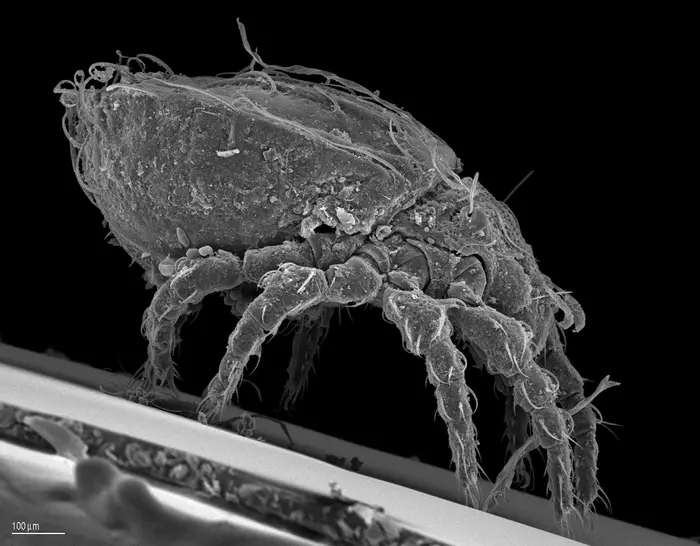
In a groundbreaking study from the University of Cologne, researchers have unveiled the intricate genetic mechanisms that enable the oribatid mite, Platynothrus peltifer, to thrive in asexual reproduction. Published in the esteemed journal Science Advances, this research has the potential to reshape our understanding of evolutionary biology. For over 20 million years, this remarkable mite has flourished entirely without sexual reproduction, challenging conventional paradigms that assert sex is crucial for evolutionary advancement.
The focus of this study lies in an innovative genomic analysis that sheds light on the asexual reproductive strategy of Platynothrus peltifer. Unlike most organisms, which benefit from genetic variation through sexual reproduction, this mite reproduces parthenogenetically, giving rise to female offspring from unfertilized eggs. This reproductive method results in a population composed solely of females, raising questions about how genetic diversity is maintained without the introduction of male genes.
One of the pivotal discoveries presented in this research is the ‘Meselson effect,’ a phenomenon where the two copies of chromosomes in the asexual mite evolve independently. This could be the key to understanding how this mite can persist over millions of years despite lacking sexual reproduction. By employing advanced genome sequencing techniques, the researchers meticulously analyzed the variations between the two chromosome sets, revealing significant divergences that contribute to genetic diversity and adaptability.
The study highlights the role of independent haplotype evolution, wherein each chromosome set accumulates distinct mutations over time. This unique adaptation allows Platynothrus peltifer to respond effectively to environmental changes, thereby providing a survival advantage in a world where changing conditions can be perilous for many species. Such findings suggest that asexual organisms may harness independent chromosome evolution to develop resilience—even in the absence of sexual reproduction.
In addition to haplotype evolution, the researchers delved into other mechanisms that facilitate genetic diversity. Horizontal gene transfer (HGT) emerged as another crucial factor in the mite’s survival strategy. By acquiring new genes from other organisms, this mite can enhance its capabilities beyond the limitations of its own genome. For example, some of these genes may enable the mite to digest a wider variety of food sources, thereby expanding its ecological niche and overall survival prospects.
Moreover, the study scrutinizes the role of transposable elements, often called “jumping genes.” These genetic snippets can move around within the genome, thereby introducing dynamic changes. The researchers observed that the activity of these transposable elements varies significantly between the two chromosome copies. This variance allows one set to adapt while the other retains essential genetic information, an evolutionary strategy that offers substantial advantages to the asexual mite.
The implications of such findings extend beyond just Platynothrus peltifer. They challenge long-standing beliefs about the necessity of sexual reproduction in evolutionary processes. The researchers argue that the mechanisms allowing for genetic innovation in asexually reproducing organisms like this mite could offer insights into how life adapts and persists in a rapidly evolving world.
The research team’s work has broader significance for understanding biodiversity and the evolution of life forms. It raises intriguing questions about other asexual species and their survival strategies. How do these organisms maintain genetic diversity? What other mechanisms might they employ to avoid genetic stagnation? These queries will undoubtedly guide future research aimed at uncovering the mysteries of asexual reproduction and evolution.
Dr. Hüsna Öztoprak, a lead author from the University of Cologne, expressed excitement regarding the implications of their findings. “Our study elucidates how asexual organisms can survive for millions of years even without sexual reproduction. By uncovering these mechanisms, we are changing the narrative on how evolution functions in various life forms,” she stated.
Additionally, Dr. Jens Bast, a group leader involved in the project, indicated that further research is warranted to explore additional genetic mechanisms that could play critical roles in the evolution of asexual organisms. “This study is just the beginning. We are eager to identify more processes that make evolution possible even in the absence of male counterparts,” he remarked.
The researchers believe that these insights could eventually lead to innovative approaches in fields such as agriculture and conservation. By understanding the genetic strategies employed by resilient species, scientists might develop methods to bolster genetic diversity in vulnerable populations or even apply such strategies in agricultural practices to enhance crop resilience against climate change.
Overall, the study of Platynothrus peltifer opens new avenues for exploration, emphasizing that life can thrive in myriad forms and that asexual reproduction does not preclude evolutionary success. As science continues to unravel the complexities of genetic diversity and survival strategies, we might discover even more astonishing examples of life’s adaptability.
Subject of Research: Asexual reproduction in oribatid mites
Article Title: Chromosome-scale genome dynamics reveal signatures of independent haplotype evolution in the ancient asexual mite Platynothrus peltifer
News Publication Date: 24-Jan-2025
Web References: DOI link
References: Science Advances
Image Credits: Dr Mark Maraun und Dr Katja Wehner
Keywords: Oribatid mite, Platynothrus peltifer, asexual reproduction, genetic diversity, Meselson effect, chromosome evolution, horizontal gene transfer, transposable elements, evolutionary biology, Science Advances.
Tags: advanced genome sequencing techniquesAsexual reproduction in miteschallenges to conventional evolutionary paradigmsevolutionary biology breakthroughsfemale-only populations in naturegenetic diversity without sexual reproductiongenomic analysis of mitesimplications of asexual reproduction evolutionlong-term survival strategies of mitesMeselson effect in asexual speciesparthenogenesis in oribatid mitesPlatynothrus peltifer genetic mechanisms





